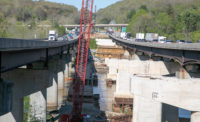Roadways that communicate with and charge the electric vehicles that drive on them. Smart freeway ramps that direct cars away from traffic jams. Autonomous trucks that deliver freight faster and safer, with less stress on highways and bridges. These are just a few of the innovative transportation concepts, once considered impossible, that could become reality in the near future.
But, first, those technologies must be tested under real-time road conditions. That’s where the Colorado Dept. of Transportation’s new program comes into play. Dubbed RoadX, it seeks to revolutionize transportation systems and implement a slew of bold mobility concepts within the next 10 years. CDOT says all of that can happen by investing in innovative technologies and creating industry partnerships that will result in crash-free travel with fewer delays. The agency has allocated $20 million in public funding for the first two years of the program.
“The goal of RoadX is to capture and partner with the private sector in bringing these formative technologies to enhance Colorado’s transportation system,” says Amy Ford, director of communications for CDOT. “We can’t afford to wait. There are significant issues and limited dollars. And we think this technology has the possibility of helping us become injury-free.”
Three large design firms—AECOM, CH2M and Atkins—are partnering with CDOT to provide program support for RoadX. Collectively, this “champions” team works in a design, advising and training capacity, says Atkins RoadX champion Jim Hanson.
The champions will reach out to innovators, evaluate ideas and encourage people to submit new ideas, he says. “The real challenge is with the human component. That’s a big part of RoadX. It’s all being done for the public good as a form of ‘social listening.'"
The contracting community will have a role to play, as well. Firms already are building highways and bridges that use a variety of technologies, and contractors are being proactive in embracing transportation innovation, says Peter Kozinski, director of Colorado’s RoadX program. “There are great synergies to be had in this, together with infrastructure—to be installed in the future—and higher-tech-type engagements.”
Kozinski hints at the wider use of autonomous trucks and the untapped potential for easier removal of materials from jobsites, innovations that, ultimately, will affect the contractor’s bottom line. These advances may not be as far off as they sound. RoadX recently partnered with Otto of Uber to complete the world’s first commercial delivery via a self-driving truck, which picked up a load of beer at Anheuser-Busch in Fort Collins and drove it south to Colorado Springs. A driver monitored the experiment from the truck’s sleeper cab. The nearly 120-mile trip is a key next step in advancing safety solutions that could reduce highway deaths, CDOT says.
“In the next 10 to 15 years, we will see upward of three million connected vehicles on the roads. And the Feds just issued rules mandating all car manufacturers to install dedicated short-range radio that allows vehicle-to-vehicle communication,” Ford says.
RoadX also is developing a pilot program with 1,000 people to deliver real-time safety alerts via cellular networks to connected and autonomous drivers along the challenging Interstate 70 mountain corridor. A separate partnership with Panasonic will create a statewide interoperable data platform for connected vehicles. These innovations represent some of the first major changes in transportation since the invention of the car.
“One of the goals of RoadX is to operate as a group under a faster set of protocols,” says CH2M RoadX champion Mary Jo Vobejda. “You can see the dilemma: Big projects can take 20 years from concept to construction [yet] emerging technology could potentially be obsolete in 10 years.”
Ford says RoadX includes sustainability concepts, such as induction charging for electric vehicles. “CDOT is unique in that it is the first DOT in the U.S. providing access to real-world conditions to test [this technology],” says AECOM RoadX champion Andrew Liu.
AECOM has proposed to CDOT a one-mile pilot project to install in the roadway induction coils, which will charge electric vehicles. “We will test how efficiently the coils in the ground can wirelessly transfer power to a vehicle as it drives down the road,” says Liu.
He predicts that, within the next five to 10 years, new technology will enable multiple manufacturers to produce light-duty vehicles that can travel 300 miles on a single charge. However, this will be harder to achieve with larger trucks. AECOM proposes turning the road into a utility of sorts. Induction charging could be the key to fully electrifying the movement of freight.
“For freight trucks, the batteries required to achieve a similar range [300 miles] will be heavy, expensive and take a long time to charge, making it impractical to implement,” Liu says. “We can take some of that battery requirement out of the vehicle and put it into the roadway.” Further, lighter trucks will reduce damage to roads, he says.
The Rocky Mountain Hyperloop is another partner project of RoadX and AECOM. The levitation-based technology uses electric-propulsion, high-speed tube trains to carry cargo and passengers at speeds of up to 700 mph. The segment recently was selected as one of 35 semifinalists in the Hyperloop One Global Challenge.
“RoadX is still in its infancy. Over the next two to five years, we’ll see continued massive technology transformation,” Ford says. “It’s like a race to the moon in the transportation sector. The autonomous vehicle is driving that race—and that changes everything.”





